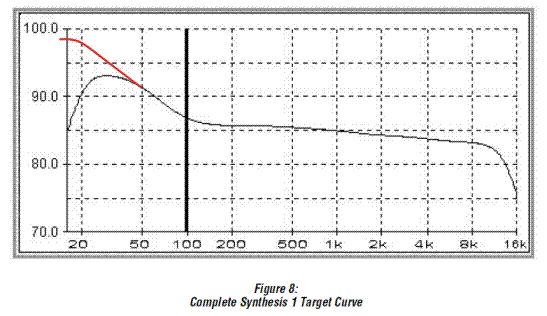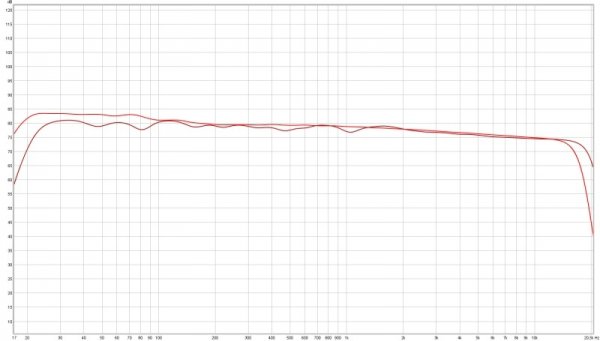At the extreme, this problem is not analyzable. You cannot zoom in too much in the data and expect to get anywhere. These are systems which produced very different sounds. With no reference sound that is known to be "correct," we cannot make any absolute judgments.
What we can do, and what the paper does and I and countless others state, is high-level correlations...Until such time that you create controlled tests and extrapolate those insights, and show why the contradictions with other tests makes sense, we have to go by what has been learned over the years here. And that calls for these two strategies in correcting system response:
1. Smooth frequency response (not be confused with "flat" frequency response). This calls for taking out the peaks in bass frequencies.
2. Sloping down response from low to high frequencies. Not just a treble tilt but increase in bass.
We could fight this learning with no alternative listening test data or accept it and optimize from there. I live and breath this stuff and that is where I am.
The automatic is good enough for majority of cases. The manual is for someone who wants to experiment. This is only true if you follow the above target curve.
We appear to be stuck in a cycle. I hope I can end it with this last post.
Harman study concluded that smoothed and extended frequency response is preferable and that the preferred target EQ is not flat. That is direct paraphrase from Dr. Olive's slides.
I am in complete agreement with these conclusions so I am having difficulty understanding why you seem to feel that I question them.

What I am questioning is the assertion that a straight fixed slope target is optimal starting point for auto EQ by any standard of measure. It may be customary, it may be preferred in the Harman study, it may work well for some people, but as far as I know no one has yet used an EQ with the processing power and tight error limits of the Harman system to compare that target you prefer to the alternative target I proposed.
Also, Dr. Toole apparently disagrees with your assertion, as apparently also Onkyo disagrees.
Toole seems to think that no auto room EQ works well regardless of target curve.
Onkyo design and marketing seems to think that measuring the power response of a speaker in the actual listening room to develop the EQ target provides some benefit.
Onkyo EQ per descriptions I have read anyway seems to measure the front l/r and EQ the rest of the system to the derived target instead of using that target to smooth and extend the frequency response of the speakers they measure, so in that respect their approach also seems questionable to me. I would prefer they apply the derived target to the same speakers they are measuring.
Moreover, I demonstrated that the data presented in Dr. Olive's presentation does not show any change in the global power spectral balance of the equalized speaker system. The preferred targets (RC1-RC3) seem by inspection to closely align with a curve-fit approximation to the unequalized speaker response in that room.
Since your opinion has at least two prominent counter-examples that I can readily point to and visual inspection of the plots in the Harman study seems to support my proposed approach, I have to respectfully disagree (sadly) on a theoretical level and leave it at that. I do not have the funding to provide proof of the validity of my proposal and I never presented it as anything other than a thought experiment, although I did attempt to explain and defend my reasoning in detail. I am sorry if this does not meet the WBF standard for discussion but it is the best that an outsider without funding can do.
You asked me several times to clarify my proposal and indicated that the details are still a mystery to you. In the absence of any funding or time to document and implement it, I have to simply state it in the most concise terms I can and let you make of it what you will.
I hope that some good comes of the following summarized proposal some day, and then, sadly, I will let the matter drop to avoid inflaming the dialog more than it already is.
These are the assumptions I make:
This proposal applies primarily to small listening rooms but could be extended to larger rooms with appropriate measurement definitions that can detect treble attenuation due to distance travelled through air. For very small spaces cabin gain becomes a major factor and I have little knowledge regarding how to handle that so I defer any statements regarding that aspect.
Pro speaker has a mostly flat and extended anechoic on-axis frequency response by design as illustrated in numerous publications. It also has smooth (and smoothly varying) off-axis treble attenuation as a direct consequence of its inherently increasing directivity with increasing frequency. The absolute character and detail of these properties are under the control of the speaker designer and the tradeoffs are made such that a speaker sounds good
in appropriate listening room without any outside intervention by room EQ.
Room EQ can only measure power response contaminated by the inevitable room-induced distortions in the spectral balance. The in-room power response integrates the magnitude and phase response of all energy radiated in all directions by the speaker that has not been absorbed on its way to the microphone. The power response is the only remnant of the original intent of the speaker designer that can be objectively determined once a speaker is placed inside the boundaries of an enclosed space.
When placed into a room, the mostly flat on-axis frequency response becomes unavailable to the auto room EQ measurement system due to the reflections off any boundaries and similarly the on-axis response cannot be directly perceived by a human either. Presumably, precedence effect enabled by the head-related transfer function and other psychoacoustic perceptions can provide clues to the on-axis response or else speaker designers would ignore the on-axis response and concentrate entirely on the in-room power response when designing a speaker.
Dr. Toole has referred to this precedence etc. psychoacoustic effect as 'hearing through the room' and it appears to be the primary motivation for purists refusing to EQ the frequency response of a pro system that has been installed in an acoustically controlled environment.
The acoustic characteristics of the room are typically tuned so that the sound of the chosen speakers will be optimized in that room and presumably, pro speakers anticipate the absorptive characteristics of their optimal environment when their response is tuned during the design phase.
It is desirable to EQ out as much of the spectral distortion as possible while preserving as much of the original spectral intent of the speaker designer as possible, and also while extending the frequency response beyond its inherent unequalized bandwidth limitations in such environment.
These are the details of my proposal:
In the absence of any anechoic measurement data, the only way of determining the original intent of the speaker designer is to measure the actual speaker in the actual room so that is what I am proposing to do. I am proposing to replicate the original intent of the speaker designer in the resultant speaker response, smooth that response, and extend its bandwidth based upon a target that is objectively determined via power response measurements with a microphone in the actual listening room.
Moreover, I am proposing to ask the user to identify each channel as belonging to a group of speakers in the system that are all the same model so that their measured response can be averaged or otherwise combined into a more accurate target that more closely resembles the original intent of the speaker designer.
Another aspect is that the derived target for a group can be individually tailored by the auto algorithm to incorporate aspects of in-room response specific to a channel. If no averaging or combining of response is deemed desirable the derived target can be completely specific to a channel. These details remain unknown and I am of course speculating but my suspicion is that subtle differences in the location-specific psychoacoustics could lend themselves to individual tailoring of channels and that the resulting response could provide the listener with a more coherent image if the individual character of the resultant power response of each channel is preserved to some extent.
The inherent frequency response of all speakers tends to have a curved rolloff at the frequency extremes. All room EQ (auto or manual) that I am aware of preserves some semblance of this curved rolloff because to do otherwise would push the equipment beyond its natural limits of operation.
The most appropriate smoothing and extending function for such a system is a second-order function and an appropriate error function to apply smoothing with is least squares. For customization in the event that the resulting slope and curvature is not to preference, or the algorithm has converged on a suboptimal target, two manual control factors can be implemented that will arbitrarily tweak the target to preference in slope and curvature including reversing the slope and curvature if desired, but the countour of the target EQ function will preserve the general natural concavity of the overall power response to preserve the relationship between the on-axis response and the power response particularly at the inflection point in the region where the speaker first starts to become a directional radiator.
The resulting auto EQ target will represent a close approximation of the original intent of the speaker designer because it will directly measure that intent in the only way possible when no anechoic measurements are available. The target will also be customizable so that any second-order fit including a straight line of adjustable slope can be derived. Even an inversion of curvature or slope can be induced.
Disclaimers:
I understand that my suppositions and proposals are speculative and run counter to commonly accepted practices and beliefs. That is the nature of progress. Some ideas pan out and others do not. At this time there is no way to tell but I wanted to share my ideas just in case they hold value for someone of greater means than I to analyze and implement them. I am explicitly giving up my rights to any such invention in publishing here so please consider that what I am presenting is a gift, not an argument.
That is it, Amir. If I made any invalid assumptions or any technical errors due to my lack of experience, I apologize for my limitations. I also apologize for any perceived insult to anyone because there was no such intent. Any appearance of disrespect is likewise a representation of my limitations and I apologize profusely and unreservedly for any perception that my intentions in the course of this debate have been anything but entirely honorable. Any statements I made were intended to illustrate and explain my proposal according to the letter and spirit of the terms of use.








